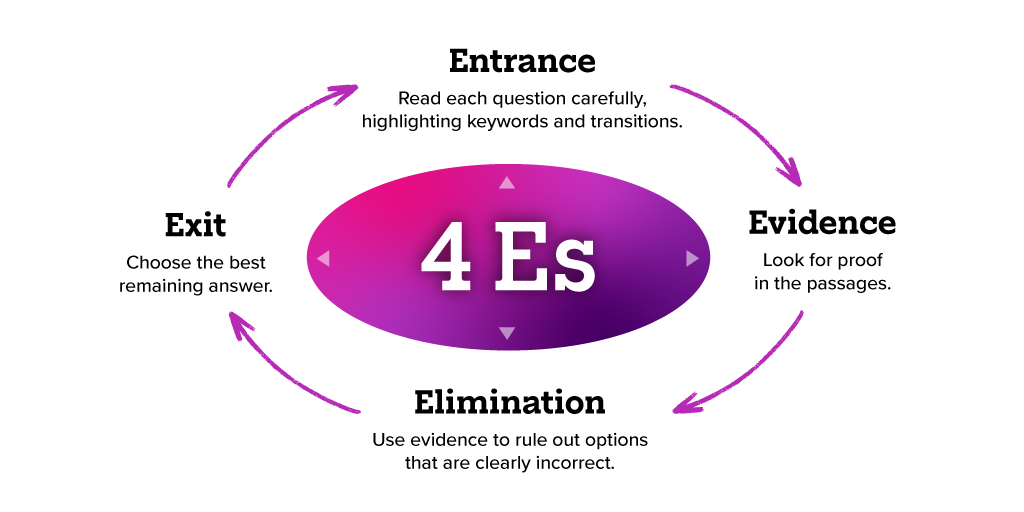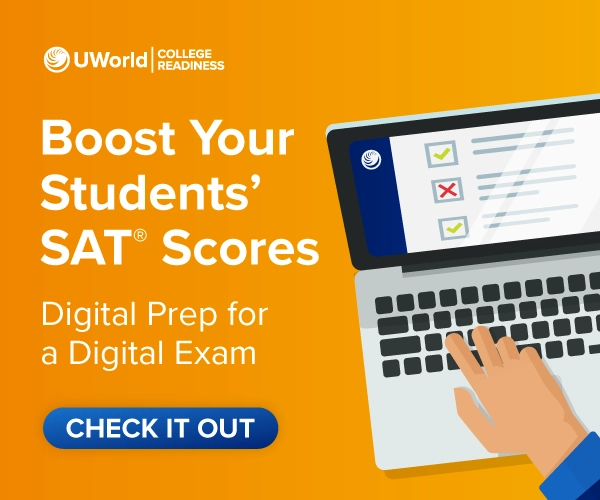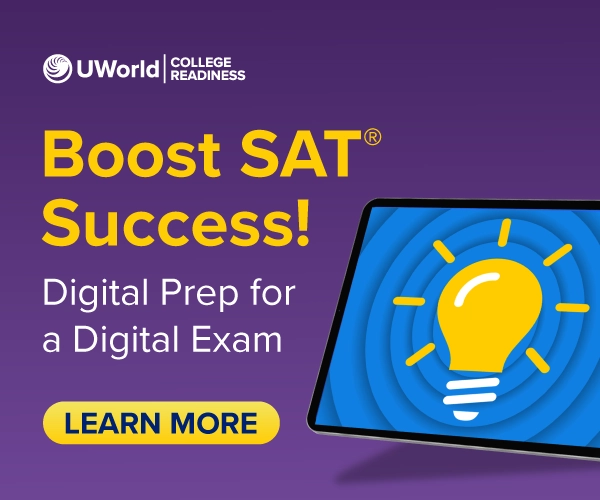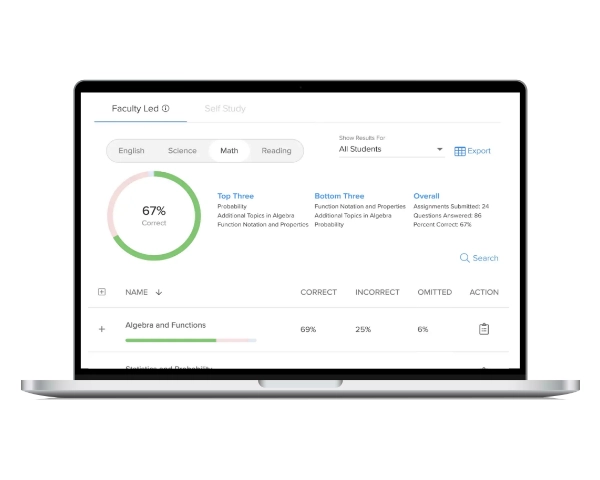As the philosophical saying goes, the only constant is change. That's especially true about the SAT exam. With the exam's shift to a digital format, educators and school leaders must rethink their instruction, assessment, and readiness approach.
It's not about simply “teaching to the test,” educators can focus on the most impactful strategies that fit naturally within daily classroom instruction. When implemented well, these methods boost student performance while promoting digital literacy, building academic confidence, and fostering real-world skills that serve learners beyond test day.
The Digital SAT's Impact on Teaching
The digital SAT presents both challenges and opportunities. It features a shorter, 2-hour 14-minute duration, multistage adaptive modules, an integrated Desmos calculator for all math sections, and faster score reports. Each student receives a unique test form, increasing security and eliminating the need for a concordance between digital and paper scores.
Although the content domains (Reading & Writing and Math) remain familiar, the digital format demands much more from instruction. Given the new digital tools and time-managed modules, teachers are now expected to prepare students academically and technologically. This calls for a meaningful shift in classroom planning, emphasizing digital fluency, targeted practice, and equitable access to technology.1
Seamlessly Integrating SAT Exam Practice
Modern SAT classroom strategies work best when they support core instruction, not disrupt it. Embedding SAT-aligned practice into weekly lessons allows students to build comfort and competence gradually. Here are a few classroom-tested techniques:
- SAT question-of-the-day bell ringers: Starting class with a daily warm-up question drawn from SAT-style prompts introduces test logic without overwhelming students.
- Weekly 15- to 30-minute practice blocks: Allocating short, consistent blocks of time reinforces skills and creates space for reflective error analysis.
- Using real student mistakes as teaching tools: Analyzing authentic misconceptions can deepen student understanding and normalize learning through error.
By incorporating these activities organically into classroom instruction, educators avoid a narrow test-prep focus. Instead, they foster lasting academic skills in literacy, grammar, problem-solving, and reasoning. They also boost student engagement and motivation and mitigate test-prep fatigue or burnout.2
Strategic Reading and Writing Approaches
The digital SAT's new format rewards students who can read critically and respond quickly. To support this, teachers can introduce strategies that help students break down questions, spot relevant information, and confidently apply grammar rules. These tactics shape them into more efficient readers and more precise writers.
4 Es Method
The digital SAT's shorter passages and 1-question-per-passage design call for new reading comprehension strategies. To help students purposefully approach each question, teachers can use structured techniques such as the “4 Es” method:

Students who habitually define tasks, locate relevant support, remove incorrect answers, and select with confidence sharpen their test-taking skills and increase their chances of exam-day success.3
Additional Teacher-Recommended Methods
Seasoned educators also suggest teaching a combination of other practices to help students answer reading and writing questions faster and more accurately.
- Visualization and predictions: Students mark key ideas, transition words, and the main idea while reading to avoid re-reading and wasting precious time.
- Answer elimination: A component of the 4 Es, this strategy helps students quickly identify wrong choices by searching for qualifiers (e.g., “never,” “always,” “only”), irrelevant information, grammatical errors, biases, or inconsistencies.
- Key rule mastery: When students have a deep understanding of core grammar rules, they can apply them instinctually.
- Active annotation: This method leads to quicker answer selections. The digital SAT features a built-in annotation tool to help students highlight text, underline key phrases, and add notes — just as they would on paper.
- Preemptive answering: Students who supply mental answers before reviewing choices increase their chances of answering correctly, especially for fill-in-the-blank or sentence-completion questions.
The goal is to give students proven methods to efficiently and precisely move through dense material. They'll be more confident when approaching the SAT Reading and Writing section when they have a handful of strategies in their toolkit.4
Success on the digital SAT Math section depends on content knowledge, strategy, timing, and tool fluency. Educators who combine core instruction with focused practice on pacing, calculator use, and problem-solving methods can help students navigate this section with more confidence.
Calculator Fluency and Pacing
In the digital SAT, the calculator is permitted throughout the math section, and students can access an integrated Desmos graphing calculator. Classroom strategies should help students:
- Practice with Desmos regularly, understanding its graphing functions, table tools, and basic algebraic capabilities.
- Complete timed drills to sharpen calculation speed and accuracy.
- Focus on test-relevant domains like algebra, advanced math, and data analysis.
Since the test is adaptive, early accuracy can influence the difficulty of subsequent questions. So, students benefit from strategies that boost confidence in foundational math before advancing into complex problem sets.5
Problem-Solving Strategies
Educators can help students tackle even complex problems with clarity by teaching strategic approaches to answering math questions. These methods are especially valuable in a timed, adaptive test environment.
- Pattern recognition: Students look for recurring formats like sequences or decimals to avoid repetitive calculations and solve problems faster.
- Plugging in numbers: Test takers select numbers to plug into complex equations packed with variables. This is especially helpful in student-produced response questions, where no answer choices are available.
- Active annotation: Like the Reading and Writing section, students can call attention to important information via the built-in annotation feature. Highlighting a problem's core question helps prevent errors like solving for the wrong variable.
The Math SAT section demands more than just sharp mathematical savvy. Top-scoring students learn to become adept test takers, quickly applying strategies that help them solve problems in a fraction of the time. By emphasizing both skill and strategy, educators can set students up for test-taking success.6
Time Management and Low-Stress Practice
Time pressure remains one of the biggest challenges in standardized testing. The digital SAT includes countdown timers for each module, so students need to balance pacing and accuracy. Educators can help students manage time by:
- Incorporating practice tests with real-time modules
- Teaching how to flag and revisit questions
- Emphasizing that guessing has no penalty, so no questions should be left blank
Consistency is key. When students habitually regulate their pace, they sharpen a valuable skill for any timed environment.

Teacher and Student Challenges
Even the best SAT prep plans can fall short if they don't account for the real-world pressures that teachers and students face. Addressing these human challenges is essential to creating a supportive, effective learning environment.
Supporting Educators
Educators carry a heavy load, and integrating SAT prep can feel like another demand on an already packed plate. To mitigate burnout, school leaders can support teachers by encouraging reasonable expectations for prep integration and offering helpful strategies to lead digital SAT prep, support teachers, and ensure student success.
Teachers who feel supported and resourced are more likely to approach SAT exam preparation with energy, creativity, and confidence. And that enthusiasm will be contagious in the classroom.
Helping Students Overcome Test Anxiety
While test anxiety is a common barrier for many students, it can be overcome with a combination of healthy practices. In addition to incorporating positive reinforcement, teachers can encourage test takers to observe the “3 Rs”:
- Recognize symptoms of stress (e.g., headaches, tightness in the jaw, restlessness).
- Regroup by pausing to gather yourself so you can pivot to a new response.
- Redirect with activities that foster well-being (e.g., breathing exercises, positive self-talk).
Educators can play a significant role in reinforcing the 3 Rs. Equally important is instilling student confidence. This can be done by familiarizing students with digital tools, scheduling regular low-stakes practice, and cultivating a classroom culture where mistakes are expected — and even celebrated — as part of the learning process. After all, the goal is progress, not perfection.7
School-Level Support and Administrator Action
SAT prep is much more successful at scale with administrative support. Schools administering the SAT exam on campus (via SAT School Day) must coordinate logistics, train staff, keep state provisions in mind, and ensure equitable access to test prep resources.
Best Practices for SAT School Day
Administrators should understand the processes involved in in-school SAT testing to ensure that the operation runs smoothly for students and teachers.
Leveraging College Board® Resources
College Board® offers a suite of digital tools to make SAT exam administration and analysis more efficient for educators. These resources support everything from test preparation to score interpretation, helping schools turn data into action.
- The K-12 Reporting Portal allows educators to access student SAT Suite assessment scores, run reports, and download student data for their schools.
- The SAT Suite of Assessments Educator Experience helps teachers prepare for, administer, and analyze results from SAT-related assessments (e.g., SAT, PSAT/NMSQT).
- The Skills Insight™ tool helps educators, students, and families interpret SAT Suite assessment scores by linking them to specific skills and knowledge demonstrated at different statistical ranges for the Reading & Writing and Math sections.
- Bluebook offers test previews (untimed, unscored question sets that let students experience digital testing tools) and timed, full-length practice tests that are scored and replicate the real exam.
By incorporating these tools into their SAT exam prep and planning workflows, educators can better target instruction, track student growth, and make informed decisions that support long-term academic success.
Importance of Professional Development
The SAT's ever-changing nature requires educators to stay 2 steps ahead. This is true for well-prepared teachers and those actively seeking resources to serve their students better. Administrators can ease the burden by providing professional learning opportunities like those offered by College Board and trusted online educational platforms. Districts should also prioritize adequate time, funding, and personnel to avoid overburdening staff, especially during busy testing windows.
Building a Culture of Growth, Not Just Scores
More than a means to boost scores, SAT preparation in the modern classroom is an opportunity to reinforce essential skills. When students hone in on digital literacy, time management, strategic thinking, and emotional regulation, they succeed in college, careers, and life.
Teachers can meet SAT exam objectives by aligning classroom strategies with these goals while enhancing instruction. And when school leaders empower educators with the right tools, time, and training, the benefits extend beyond test day.
Frequently Asked Questions (FAQs)
What changes should educators know about the 2025-26 SAT exam format?
The SAT is now fully digital, featuring a 2-hour adaptive format, shorter reading passages, and a built-in Desmos calculator for all math sections. Each student receives a unique test version, and score reports are available more quickly. See The Digital SAT’s Impact on Teaching.
How can schools prepare students for the digital SAT?
Schools can prepare students by integrating SAT exam practice into regular classroom instruction, using short, consistent activities such as bell ringers or timed drills. Emphasizing academic content and digital fluency — such as using Desmos and navigating adaptive modules — builds confidence over time. Tools offered by UWorld and College Board support skill growth without overwhelming teachers or students. See Seamlessly Integrating SAT Practice.
How can teachers reduce student SAT exam anxiety?
Teachers can reduce anxiety by incorporating mindfulness practices, normalizing mistakes, and using consistent low-stakes practice. Encouraging the “3 Rs” (Recognize, Regroup, Redirect) gives students a practical way to manage stress. See Helping Students Overcome Test Anxiety.
What is the role of administrators in SAT prep?
Administrators support SAT exam success by coordinating logistics, training staff, and ensuring access to resources and technology. They also help align prep efforts with state policies and reduce teacher burnout through professional development and realistic expectations. See School-Level Support and Administrator Action.
References
- College Board. (2024, March 9). Digital SAT launches across the country, completing transition to digital and providing simpler testing. College Board Newsroom. https://newsroom.collegeboard.org/digital-sat-launches-across-country-completing-transition-digital-and-providing-simpler-testing
- College Board. (2025). Educator guide: Building your students' skills through practice [PDF]. https://satsuite.collegeboard.org/practice
- College Board. (2025). SAT student guide: Digital SAT [PDF]. https://satsuite.collegeboard.org
- Borchelt, A. (2020, August 28). Top 10 tips for taking multiple-choice tests. ThoughtCo. https://www.thoughtco.com/multiple-choice-test-strategies-3212049
- Campus Bound. (2024, March). What we've learned about the new SAT and how it affects students. https://campusbound.com/what-weve-learned-about-the-new-sat-and-how-it-affects-students
- Wyzant. (n.d.). What's the best strategy to improve in SAT math quickly? Wyzant Resources. https://www.wyzant.com/resources/answers/953452/what-s-the-best-strategy-to-improve-in-sat-math-quickly
- American Medical Associates. (2020, October). Take control of your anxiety using the three R's. https://www.amatxmed.com/blog/2020/october/take-control-of-your-anxiety-using-the-three-rs-
- College Board. (2025). SAT weekend: Key information for test coordinators [PDF]. https://satsuite.collegeboard.org
- College Board. (2025). SAT Suite test coordinator manual [PDF]. https://satsuite.collegeboard.org
- College Board. (n.d.). Test coordinator duties. SAT Suite of Assessments – K–12 Educators. https://satsuite.collegeboard.org/k12-educators/educator-experience/in-school/on-test-day/test-coordinator-duties










